
Antenna
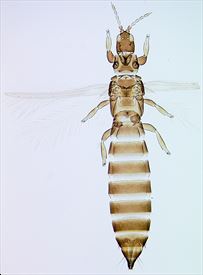
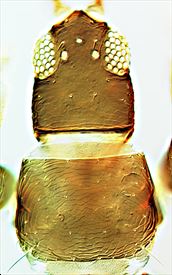
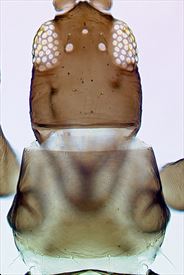

Pronotum
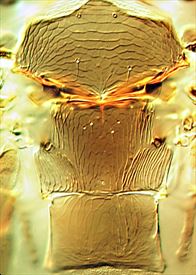
Meso & metanotum

Tergites VIII-X
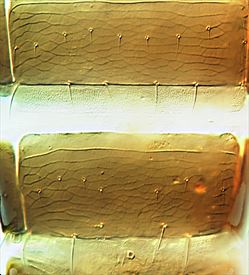
Female sternites VI-VII
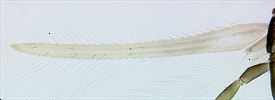
Fore wing
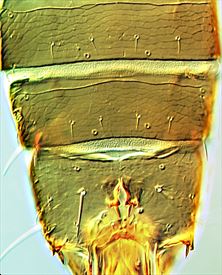
Male tergites VII-IX
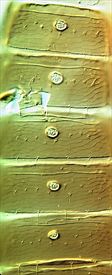
Male sternal pore plates
Distinguishing features
Female fully winged. Body brown, tarsi yellow, antennal segment III light brown with pedicel yellow; fore wings light brown. Antennae 8-segmented, III asymmetric with simple sense cone on slight lateral prominence, IV with simple sense cone. Head longer than wide, projecting in front of eyes; with 3 pairs of ocellar setae; pair III anterolateral to ocellar triangle, scarcely longer than distance between two ocelli; postocular setae small. Pronotum with 1 pair of long posteroangular setae, posterior margin with 3 pairs of setae. Metanotum reticulate, campaniform sensilla present, median setae arise behind anterior margin. Meso- and metafurca without spinula. Fore wing first vein with 2 setae on distal half, second vein with about 8 setae. Tergites reticulate medially, paired campaniform sensilla close to posterior margin, craspedum not developed; tergite IX with 1 pair of stout thorn-like setae. Sternites II–VII with 5–10 discal setae, without craspeda.
Male apterous. Head without ocelli; pterothorax transverse without wing buds; tergite IX with 2 pairs of equally small stout setae on tubercles, 1 pair medially, 1 pair laterally with elongate projection on one side; sternites III–VII with small sub-circular pore plate.
Related species
Females of the genus Limothrips are characterised by the presence of a pair of unusually stout setae on the ninth tergite. Eight species are listed in this European genus, although two are of doubtful validity. Three species are now widespread around the world in temperate areas, and although all three have been found in southern areas of Australia only the most common species, L. cerealium, is known from New Zealand. This species has the external apical margin of antennal segment III weakly prolonged laterally.
Biological data
This thrips feeds and breeds on the leaves of grasses and cereal crops, including Hordeum and Triticum (Poaceae). In Europe, adults of this species are referred to as "Thunder Flies" because of their habit of swarming in late summer. These swarms can cause serious problems by entering smoke detectors and causing fire alarms to sound.
Distribution data
This European species is widespread in New Zealand, and is found worldwide in temperate areas.
Family name
THRIPIDAE, THRIPINAE
Species name
Limothrips cerealium (Haliday)
Original name and synonyms
Thrips (Limothrips) cerealium Haliday, 1836: 445
Limothrips avenae Hinds, 1902: 139
Limothrips aptera Karny, 1914: 56
Limothrips minor Bagnall, 1927: 565
Limothrips adusta Maltbaek, 1927: 14
Limothrips cerealium ssp. astutus Priesner, 1964: 115
Limothrips syriacus Jenser, 2009: 83
References
Mound LA, Tree DC & Paris D (2012) OzThrips – Thysanoptera in Australia. http://www.ozthrips.org/
zur Strassen R (2003) Die terebranten Thysanopteren Europas und des Mittelmeer-Gebietes. Die Tierwelt Deutschlands 74: 1–271.